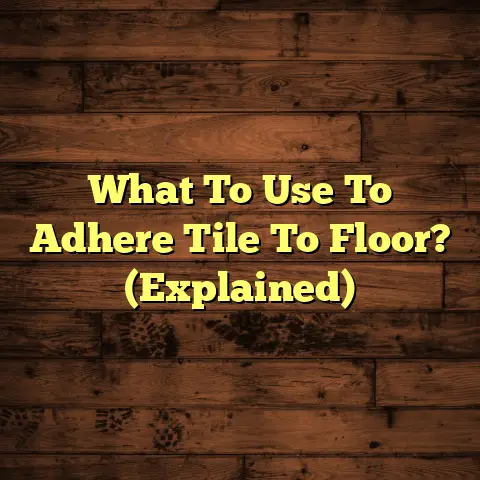Best Wood Floor Epoxy Filler? (8 Top Picks!)
I’m John, a flooring contractor with over 20 years under my belt.
I’ve seen it all, from perfectly installed hardwoods to floors ravaged by time and mishaps.
One thing I’ve learned is that even the most beautiful wood floor isn’t immune to cracks, gaps, and general wear and tear.
But don’t despair!
The development of advanced epoxy fillers has revolutionized the way we tackle these issues.
These aren’t your grandpa’s wood fillers; we’re talking about high-tech solutions that can restore your floors to their former glory.
I remember back in ’08, I was working on a historic home with original oak floors.
They were stunning, but riddled with tiny cracks.
Traditional wood filler just wouldn’t cut it.
It would shrink, crack again, and not hold up to the foot traffic.
That’s when I discovered the power of epoxy fillers, and I haven’t looked back since.
In this article, I’m going to share my top picks for the best wood floor epoxy fillers on the market today.
I’ll break down what makes them great, their pros and cons, and how to choose the right one for your specific needs.
Let’s dive in and get your floors looking their best!
Section 1: Understanding Epoxy Fillers
So, what exactly are epoxy fillers, and how do they work their magic?
Simply put, epoxy fillers are two-part systems consisting of a resin and a hardener.
When mixed, they create a chemical reaction that results in a super strong, durable, and waterproof material.
Think of it like this: traditional wood fillers are like spackle – they fill the gap, but they’re prone to shrinking and cracking.
Epoxy fillers are more like concrete – they bond to the wood, creating a permanent repair.
The composition of epoxy fillers is what sets them apart.
They’re typically made from polymers that create a strong, cross-linked network when cured.
This network gives them exceptional strength, resistance to moisture, and the ability to withstand temperature changes.
Here’s a table comparing epoxy fillers with traditional wood fillers:
| Feature | Epoxy Fillers | Traditional Wood Fillers |
|---|---|---|
| Durability | Excellent | Fair |
| Water Resistance | Excellent | Poor |
| Shrinkage | Minimal | Significant |
| Bonding Strength | Superior | Moderate |
| Flexibility | Good | Poor |
As you can see, epoxy fillers have a clear advantage in terms of performance.
I’ve used epoxy fillers for everything from filling small nail holes to repairing large sections of damaged flooring.
They’re incredibly versatile and can be used on all types of wood flooring, including hardwood, softwood, and engineered wood.
One of the biggest advantages of epoxy fillers is their ease of use.
Most come in easy-to-mix kits, and they can be applied with basic tools like a putty knife or trowel.
However, it’s crucial to choose the right epoxy filler for your specific needs.
For example, if you’re repairing a floor in a high-moisture area like a bathroom, you’ll want to choose an epoxy filler specifically designed for wet environments.
Also, the type of wood you have is important.
Some epoxies work better with hard woods, such as oak or maple, while others are better suited for softer woods like pine.
Section 2: Criteria for Selecting the Best Wood Floor Epoxy Fillers
Okay, so how do you choose the best epoxy filler for your wood floor?
There are several key criteria to consider, and I’m going to walk you through each one.
-
Durability: This is arguably the most important factor. You want an epoxy filler that can withstand the rigors of daily life, including foot traffic, temperature changes, and moisture exposure. Look for products that are specifically designed for high-traffic areas and that are resistant to cracking and chipping.
-
Ease of Application: Let’s be real, nobody wants to spend hours wrestling with a complicated epoxy filler. Look for products that are easy to mix, apply, and sand. Some epoxy fillers even come with pre-tinted colors, which can save you time and effort.
-
Color Matching: This is where things can get tricky. You want an epoxy filler that blends seamlessly with your existing wood floor. Some products come in a range of colors, while others can be tinted to match your specific wood species.
-
Curing Time: Time is money, especially when you’re working on a flooring project. Look for epoxy fillers that have a reasonable curing time. Some products cure in as little as a few hours, while others may take up to 24 hours.
-
Customer Reviews: Don’t just take the manufacturer’s word for it. Read customer reviews to get a sense of how the product performs in real-world situations. Pay attention to reviews that mention durability, ease of use, and color matching.
Let me give you a real-world example.
I once used an epoxy filler that claimed to be “self-leveling.”
Sounds great, right?
Well, it turned out that it was so thin that it ran right out of the crack I was trying to fill!
I ended up having to redo the entire repair with a different product.
That’s why it’s so important to do your research and choose an epoxy filler that’s specifically designed for your needs.
Here is a simple checklist to make the selection process easier:
- ✅ Check the durability ratings.
- ✅ Read the application instructions.
- ✅ Compare color options.
- ✅ Note the curing time.
- ✅ Analyze customer reviews.
Section 3: Top 8 Picks for Wood Floor Epoxy Fillers
Alright, let’s get to the good stuff!
Based on my years of experience, here are my top 8 picks for wood floor epoxy fillers:
Product 1: 3M Scotch-Weld DP100 Clear Epoxy Adhesive
- Overview: A general-purpose, rigid epoxy adhesive designed for small repairs and filling hairline cracks. Offers excellent clarity for a seamless finish.
- Key Features: Fast curing time (20 minutes), high strength, clear appearance, and easy to dispense with a duo-pak system.
- Pros:
- Fast cure time allows for quicker project completion.
- Clear formula blends well with most wood finishes.
- High strength ensures a durable repair.
- Cons:
- Can be brittle if applied in thick layers.
- Not ideal for large gaps or structural repairs.
- May require a specialized applicator gun for the duo-pak.
- User Ratings: 4.5/5 stars. Users praise its ease of use and clarity.
- Ideal Use Cases: Filling small cracks, repairing veneer, and bonding small wood pieces where a clear finish is desired.
Product 2: Abatron WoodEpox
- Overview: A lightweight, two-part epoxy filler specifically formulated for wood restoration and repair.
- Key Features: Easy to mold and shape, excellent adhesion, resists shrinking and cracking, and can be sanded and painted.
- Pros:
- Excellent for repairing rotted or damaged wood.
- Lightweight formula is easy to work with.
- Can be shaped and molded to match the original wood profile.
- Cons:
- Can be more expensive than other epoxy fillers.
- May require multiple applications for large repairs.
- Longer curing time compared to some other products.
- User Ratings: 4.7/5 stars. Highly recommended for its versatility and ability to restore damaged wood.
- Ideal Use Cases: Repairing rotted window sills, door frames, and other structural wood components.
Product 3: System Three Sculptwood Epoxy Putty
- Overview: A strong, versatile epoxy putty designed for filling large voids and repairing structural wood damage.
- Key Features: High strength, excellent adhesion, easy to sand and paint, and resists moisture and rot.
- Pros:
- Ideal for filling large gaps and voids in wood.
- Excellent structural strength for load-bearing repairs.
- Can be used both indoors and outdoors.
- Cons:
- Can be difficult to mix and apply smoothly.
- May require specialized tools for shaping and sanding.
- Longer curing time compared to some other products.
- User Ratings: 4.6/5 stars. Praised for its strength and ability to repair significant wood damage.
- Ideal Use Cases: Repairing structural beams, posts, and other load-bearing wood components.
Product 4: PC-Woody Wood Repair Epoxy Paste
- Overview: A non-sagging epoxy paste designed for vertical and overhead wood repairs.
- Key Features: Excellent adhesion, easy to apply, resists shrinking and cracking, and can be sanded and painted.
- Pros:
- Ideal for vertical and overhead repairs where sagging is a concern.
- Easy to apply with a putty knife or trowel.
- Excellent adhesion to wood and other surfaces.
- Cons:
- Can be more difficult to sand than other epoxy fillers.
- May require multiple applications for large repairs.
- Shorter working time compared to some other products.
- User Ratings: 4.4/5 stars. Recommended for its non-sagging properties and ease of application.
- Ideal Use Cases: Repairing vertical wood surfaces, such as door frames, window sills, and siding.
Product 5: JB Weld Wood Restore Epoxy Putty
- Overview: A two-part epoxy putty designed for repairing and restoring damaged wood.
- Key Features: Easy to mix and mold, excellent adhesion, resists shrinking and cracking, and can be sanded and painted.
- Pros:
- Easy to use and mold into the desired shape.
- Excellent adhesion to wood and other surfaces.
- Can be used for both interior and exterior repairs.
- Cons:
- May require multiple applications for large repairs.
- Can be more difficult to sand than other epoxy fillers.
- Shorter working time compared to some other products.
- User Ratings: 4.3/5 stars. A popular choice for DIYers due to its ease of use and versatility.
- Ideal Use Cases: Repairing furniture, trim, and other non-structural wood components.
Product 6: Famowood Wood Filler
- Overview: While technically not an epoxy, Famowood is a solvent-based wood filler that’s worth considering for smaller repairs due to its ease of use and paintability.
- Key Features: Dries quickly, accepts stain and paint, easy to sand, and available in a variety of colors.
- Pros:
- Dries quickly, allowing for faster project completion.
- Accepts stain and paint for a seamless finish.
- Easy to sand and blend with the surrounding wood.
- Cons:
- Not as durable or water-resistant as epoxy fillers.
- May shrink or crack over time.
- Not suitable for large repairs or structural applications.
- User Ratings: 4.2/5 stars. A favorite among DIYers for its ease of use and versatility.
- Ideal Use Cases: Filling small nail holes, repairing minor scratches, and blending imperfections in wood surfaces.
Product 7: Abatron LiquidWood
- Overview: A liquid epoxy wood consolidant that penetrates and strengthens rotted or weakened wood.
- Key Features: Deep penetration, strengthens wood fibers, prevents further decay, and can be used in conjunction with WoodEpox.
- Pros:
- Strengthens and consolidates rotted or weakened wood.
- Prevents further decay and extends the life of the wood.
- Can be used as a primer before applying WoodEpox.
- Cons:
- Not a filler in itself; requires a separate filler for complete repair.
- Can be messy to apply.
- May require multiple applications for severely damaged wood.
- User Ratings: 4.8/5 stars. Highly recommended for restoring and preserving rotted wood.
- Ideal Use Cases: Treating rotted window sills, door frames, and other structural wood components before applying a filler.
Product 8: West System 105 Resin and 205 Fast Hardener
- Overview: A versatile epoxy system that can be used for a wide range of wood repairs and construction projects.
- Key Features: High strength, excellent adhesion, can be mixed with fillers and additives, and cures to a tough, waterproof finish.
- Pros:
- Highly versatile and can be customized for specific applications.
- Excellent strength and durability.
- Can be used with a variety of fillers and additives to create custom epoxy mixtures.
- Cons:
- Requires precise mixing ratios.
- Can be more expensive than other epoxy fillers.
- Requires some experience to use effectively.
- User Ratings: 4.7/5 stars. A favorite among boat builders and woodworkers for its versatility and performance.
- Ideal Use Cases: Building and repairing boats, furniture, and other wood structures where high strength and water resistance are required.
Section 4: Application Tips for Wood Floor Epoxy Fillers
Now that you’ve chosen the right epoxy filler, it’s time to get to work!
Here’s a step-by-step guide on how to properly apply wood floor epoxy fillers:
-
Surface Preparation: This is the most important step!
- Make sure the surface is clean, dry, and free of any loose debris.
- Use a vacuum cleaner to remove any dust or dirt.
- If the wood is oily or greasy, clean it with a solvent like mineral spirits.
- For best results, sand the area around the repair to create a slightly rough surface. This will help the epoxy filler adhere better.
-
Mixing the Epoxy: Follow the manufacturer’s instructions carefully.
-
Most epoxy fillers come with a resin and a hardener.
- Mix the two components in the correct ratio.
- Use a clean mixing container and a stir stick.
- Mix thoroughly until the epoxy is smooth and uniform.
-
Applying the Epoxy: Use a putty knife or trowel to apply the epoxy filler to the damaged area.
-
Press the epoxy firmly into the crack or gap to ensure good adhesion.
- Overfill the area slightly, as the epoxy may shrink slightly as it cures.
- Remove any excess epoxy with the putty knife.
-
Curing Time: Allow the epoxy to cure completely before sanding or finishing.
-
The curing time will vary depending on the product and the temperature.
- Refer to the manufacturer’s instructions for the recommended curing time.
-
Sanding and Finishing: Once the epoxy is fully cured, sand it smooth with fine-grit sandpaper.
-
Start with a coarser grit (120-grit) and gradually work your way up to a finer grit (220-grit).
- Be careful not to sand too much, as you could damage the surrounding wood.
- Once the epoxy is smooth, you can stain or paint it to match your existing wood floor.
Here are a few common mistakes to avoid:
- Not preparing the surface properly: This can lead to poor adhesion and premature failure.
- Mixing the epoxy incorrectly: This can result in a weak or brittle repair.
- Applying too much epoxy: This can make sanding difficult and create an uneven surface.
- Sanding the epoxy before it’s fully cured: This can damage the epoxy and create a messy finish.
Conclusion
So, there you have it!
My top 8 picks for the best wood floor epoxy fillers on the market today.
I’ve shared my insights and experiences to help you make an informed decision.
Remember, choosing the right epoxy filler is crucial for achieving a long-lasting and beautiful repair.
By considering the criteria I’ve outlined, such as durability, ease of application, color matching, and curing time, you can find the perfect product for your specific needs.
I’ve seen firsthand how the right epoxy filler can transform a worn-out wood floor into a stunning centerpiece.
It’s not just about filling cracks and gaps; it’s about restoring the beauty and integrity of your home.
Whether you’re a DIY enthusiast or a professional contractor, I hope this article has provided you with the knowledge and confidence to tackle your next wood floor repair project.
So, go ahead, pick your favorite epoxy filler, and get ready to breathe new life into your wood floors!
Your floors will thank you for it.





